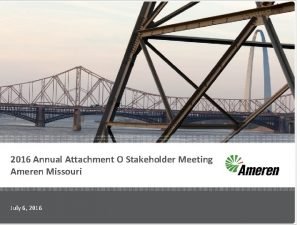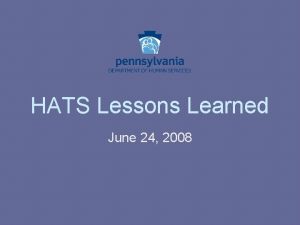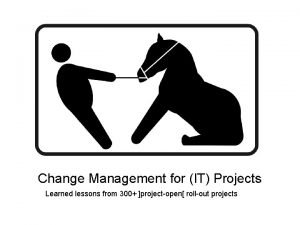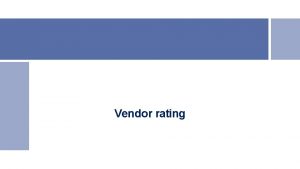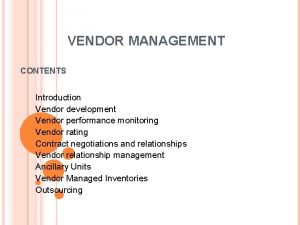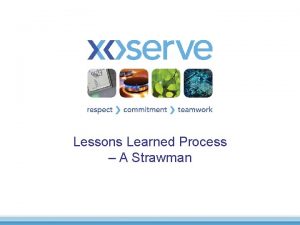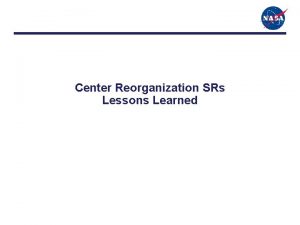Lessons Learned in Vendor Oversight Jesse Hutchison Ameren
















- Slides: 16

Lessons Learned in Vendor Oversight Jesse Hutchison, Ameren Missouri Callaway Energy Center

Case Study on Modutronics Cards

Timeline o 10/2010 - Health Issue initiated for new Modutronics cards o 6/2011 – Health Issue and solution approved (Reverse Engineer o o o o Cards) 1/2012 - Issued Purchase Order to Vendor 2/2012 – One of the old Modutronic Cards shipped to Vendor for reverse engineering 10/2014 – Engineering Approved Reverse Engineered Cards for installation 10/2014 and 11/2014 – Installed two Cards in plant during RF 20 12/2014 – One of the new Cards failed during a plant trip (bridge rectifier to DC Motor field failed) 3/2015 - Lower Tier Cause evaluation determined failure to be infant mortality based on Vendor Analysis and review of bridge rectifier design 3/2015 – Vendor analysis recommended changing out 1. 5 A Bridge

Timeline Continued o 3/2015 – Vendor started on design of new “Hybrid” Modutronics cards o o o o with 4 A bridge rectifier 3/2015 – Received INPO AFI in Engineering Oversight of Vendor Activities 8/2015 – Second Modutronics card failed after a Plant trip 8/2015 – New “Hybrid” Modutronics card installed to replace failed board (ALHV 7) 8/2015 - New “Hybrid” Modutronics card installed to replace additional reverse engineered board (ALHV 5) (No more cards installed with undersized bridge rectifier) 8/2015 – Formal Root Cause Team developed to determine cause of failure 8/2015 – Root Cause Team identified that Bridge Rectifier for DC valve motor field was undersized 9/2015 – NRC Special Inspection of Aux Feedwater System

Bridge Rectifier Circuit

What Happened Original Replacement

Failed Bridge Rectifiers First Failure Second Failure

Swiss Cheese System Engineer who started process left engineering. Turned over to new Systems Engineer. New System Engineer was working directly with Vendor to procure and test new Cards. One of the old Modutronics cards was shipped to vendor to reverse engineer along with emails containing drawing and other documentation. No formal vendor correspondance was used (only emails). Design Engineering was not directly involved in procurement of new Cards until 3 years into the process Qualification testing performed at Vendor Facility never tested/loaded the bridge rectifier circuit Callaway performed burn-in testing on the new cards for 50 hours, however bridge rectifier circuit was never loaded Original CR was downgraded so that formal root cause team was not required during first card failure. Cause was determined to be infant mortality of bridge rectifier using lower tier cause analysis. Bridge Rectifier Vendor data sheet had misleading information that led engineering to believe bridge rectifier was sized correctly

More Swiss Cheese Vendor analysis received 3/2015, clearly stated that “both bridges failed due to excessive heat buildup from the load current they were seeing”, however, neither the Vendor nor Callaway recognized this as Part 21 reportable. Furthermore, neither party recognized this as a clear design deficiency. It was simply identified as a “low margin” issue. Callaway Engineering never visited the Vendor facility during the entire Modutronics Reverse Engineering project. During the NRC special inspection, the Vendor was contacted and asked for the detailed design information used to reverse engineer the cards. The Vendor stated that the Design Engineer had left the company and that they had lost the original design information.

Corrective Actions for Modutronics Failures Provided guidance for “Proof Testing” Reverse Engineered products Clarified responsibilities for the Responsible Engineer vs. Qualification Engineer Seminars to Clarify Roles and Responsibilities around Technical Conscience Principals for Ops, Maintenance and Engineering (INPO 10 -005) Corrective Actions for INPO AFI on Vendor Oversight

INPO AFI in Oversight of Vendor Activities INPO Statement – “In some cases there has been incomplete engineering oversight of vendor activities. This has resulted in design changes that did not perform reliably when implemented and need for engineering rework when documents were accepted that did not meet requirements. Contributing were lapses in vendor engagement, insufficient owners review and knowledge deficiencies among the responsible engineers. ”

Corrective Actions for INPO AFI Implement Project Management Principles into Design Engineering o The Design Engineer is the project manager and has the o o o responsibility for managing Scope, Cost, Schedule, Procurement, and Risk. Detailed Purchase Order Requirements Use Formal Correspondence for important information (Not Emails) Weekly or Bi-Weekly Phone Calls with Vendor Level 2 Project Schedules Visits to Vendor Facilities to witness assembly, testing and ensure project deliverables Implemented Procurement Visual Management Tool (Status Boards)

Procurement Tracking Status Board

What we learned Be engaged and intrusive when using Vendors Even if the Vendor makes mistakes, you are responsible once you install it in your plant Reverse Engineering has a lot of risk. It should only be used as a last resort. It is OK to reverse engineer analog circuit cards as a “Black Box” design from your vendor. Just make sure that every change is clearly documented and understood.

Successes Identifed Fan Blades installed backwards during Fan testing at Vendor facility Identified incorrect fan mounted on Seismic table at Vendor facility getting ready for testing Engineer at Vendor site for 3 weeks to ensure Letdown throttle valve was fabricated in time for RF 21 Eliminated unqualified Vendor from EDG Relay Reverse Engineering Project by including detailed breakdown of critical characteristics in Purchase Order

Questions
 Jesse hutchison
Jesse hutchison Ameren hiring process
Ameren hiring process Ameren net metering
Ameren net metering Ameren complaints
Ameren complaints Hannah mc hutchison
Hannah mc hutchison Hannah m hutchison
Hannah m hutchison Small ideas big impact
Small ideas big impact Injury definition
Injury definition Hannah mc hutchison
Hannah mc hutchison Hydrotopia
Hydrotopia Lessons learned from king josiah
Lessons learned from king josiah Lessons learned ground rules
Lessons learned ground rules Change management lessons learned
Change management lessons learned Nerc lessons learned
Nerc lessons learned Risk management lessons learned
Risk management lessons learned Lessons learned repository
Lessons learned repository 2 chronicles 34:1-3
2 chronicles 34:1-3



